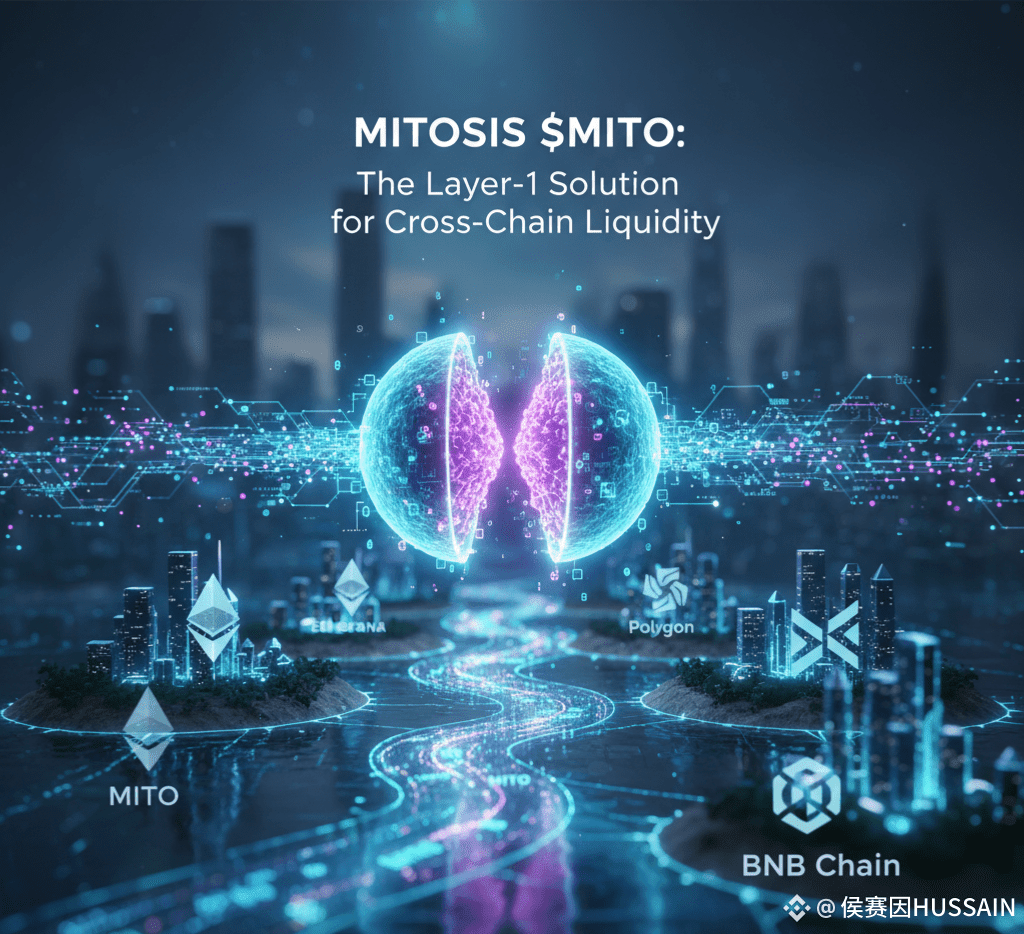
The Great Divide of Digital Assets
In the rapidly expanding universe of decentralized finance (DeFi), a silent but massive inefficiency has plagued the ecosystem: liquidity fragmentation. Think of the crypto world as a vast ocean, but instead of one unified body of water, it's a scattering of isolated lakes (the different blockchains like Ethereum, Solana, and Polygon). Your capital, your digital assets, are stranded in one lake, unable to flow freely to the other side where the best yields or trading opportunities might be. You're forced to use slow, expensive, and often risky bridges just to move your funds from Lake A to Lake B. This is the fundamental problem that Mitosis ($MITO), a new specialized Layer-1 blockchain, is designed to solve. It aims to become the unifying canal system, making the entire DeFi ocean whole again.
From Static to Programmable Liquidity
The name Mitosis itself is a clever nod to biology—the process of cell division that creates two identical copies. In the world of crypto, Mitosis is replicating the utility of your assets and making them endlessly productive. When you deposit an asset like ETH on an external chain into a Mitosis Vault, you don't just lock it up. Instead, Mitosis mints a representative token, a Hub Asset, on its own specialized L1 chain. Imagine your original asset is a passport that can only be used in one country; the Hub Asset is a global visa that represents the full value of that passport but allows you to travel and transact freely across all connected ecosystems. This "programmable liquidity" is the key innovation: your capital is no longer static or isolated, but a dynamic component that can be deployed across multiple chains simultaneously.
The Engine of Cross-Chain Efficiency
Mitosis is a Layer-1 blockchain built with modularity in mind, leveraging technologies like the Cosmos SDK for its core and Hyperlane for secure cross-chain messaging. This architecture positions it not just as a bridge, but as a dedicated financial settlement layer for the entire multi-chain world. Its primary function is to serve as a high-speed command center where a single pool of unified liquidity can be efficiently managed and allocated. For a user, this translates to true capital efficiency: you can deposit once and have that capital working to earn yield on Ethereum, Arbitrum, and other chains without ever incurring the complexity and gas fees of manually moving funds between them.
Ecosystem-Owned Liquidity: A Community-Driven Treasury
One of Mitosis's most disruptive features is its Ecosystem-Owned Liquidity (EOL) model. Traditional DeFi often relies on "mercenary liquidity," where protocols pay high, unsustainable incentive rates to rent capital from short-term providers. This leads to volatility and a race-to-the-bottom for yields. Mitosis flips the script. EOL is a communal liquidity pool where participants deposit Hub Assets and receive miAssets—tokenized shares of the collective pool. The crucial part? The strategy for deploying this aggregated capital—which external protocols to deposit into and what the allocation percentages should be—is determined by a governance vote involving the miAsset holders.
Democratizing Access to Institutional-Grade Yield
The EOL model effectively levels the playing field for every user, regardless of their capital size. By pooling assets collectively, retail participants gain access to institutional-grade yield strategies and pre-negotiated deals that were previously reserved for whales and large funds. When the community collectively controls a massive pool of liquidity, it gains negotiating power that individual participants simply don't have. This collective intelligence and scale, governed transparently by the community, is what turns Mitosis into a powerful financial engine for all of its users.
The Mitosis ($MITO) Token Utility
The native token of this dynamic ecosystem is $MITO. It's not just a speculative asset, but the fuel and foundation of the network. $MITO serves multiple roles: it's used to pay transaction fees on the Mitosis L1 chain, it's the core asset for staking to secure the network, and crucially, it's essential for governance (often via a locked or wrapped version like gMITO). Holding and staking $MITO grants you the power to vote on the strategic direction of the protocol, including new chain integrations and the allocation of the massive EOL treasury.
The Future: A Unified, Liquid DeFi Ecosystem
Mitosis is tackling DeFi's biggest scaling challenge—liquidity—with a complete infrastructure solution rather than a simple patch. By creating a dedicated Layer-1 for liquidity management and introducing concepts like Hub Assets and Ecosystem-Owned Liquidity, it provides a blueprint for a truly omni-chain future. The project suggests a world where a deposit on one chain is instantly liquid and yield-generating across all chains, dramatically reducing friction and cost.
Final Thoughts
In the complex, multi-layered world of crypto, Mitosis is making the ambitious claim of simplifying the core mechanics of decentralized finance. It’s an infrastructure play for the ages, striving to build the plumbing that connects all of DeFi into a seamless, hyper-efficient machine. For investors and users tired of fragmented capital, expensive bridging, and siloed yields, Mitosis ($MITO) presents a compelling vision: the promise of a single, unified, and infinitely programmable liquidity layer that finally allows your capital to truly flow.

